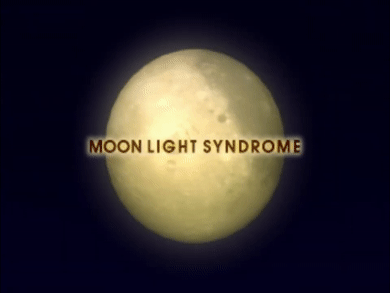

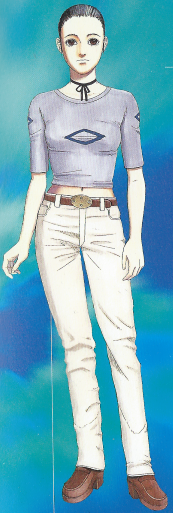
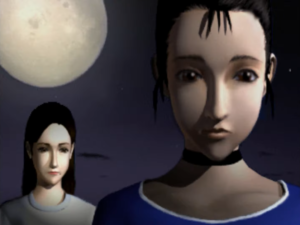
The white haired boy and his faithful servant Yayoi, the main villains of Moonlight Syndrome, are completely shrouded in mystery in the game itself. Similarly, the implications of Chisato being Yayoi’s older sister go unexplored. The name of the white haired boy would eventually be revealed as Mithra by promotional materials, such as Moonlight Syndrome’s demo disc, and several of the books that followed its release. Certain hints are also present through the game: Mithra presents himself as a God willing to save Mika’s soul, while Ryo insists that he is a demon. Yayoi and Chisato are both shown to be powerful ESPers, although their powers pale in comparison to those of Mithra, whom they ominously refer to simply as “him”. Chisato is even shown as somehow adjacent to the ghost Hanako-san, and a visual motif is established where Mithra, with his silver hair, is associated with the light of the moon.
It wouldn’t be until the release of the In-depth Guide that director Suda would shed some light onto their identity: In the Q&A which was included in the book, he revealed that the mythology of Moonlight Syndrome was based on Zoroastrianism.
Zoroastrianism is a religion from ancient Persia (modern day Iran) which is thought to have been established in around the sixth century BC. Zoroaster is the name of its founder, Zarathustra, as it is written in Greek.
It is said that the symbols of this religion are its ideas on the dualism of good and evil and its eschatology. Its good faction is led by the supreme god Ahura Mazda, who is constantly fighting against the might of the evil god Angra Mainyu, but in the end the final judgement is conferred and the powers of good prevail. After their victory, it is said that the world will be reborn into a new, ideal world.
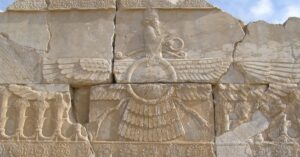
The term “eschatology” refers to an immutable fate being prophecised by a religion. In that sense, we can see the eschatological roots of the tale of Moonlight Syndrome straight away, as Mika’s ultimate fate as a sacrifice is an unchangeable reality which the characters are forewarned about several times.
Zoroastrianism served as the bedrock for following monotheistic religions; While other deities or daemons are identified within its dogma, they exist as either subservient or inferior to Ahura Mazda (literally Lord of Wisdom). In other words, the purpose of Zoroaster’s doctrine was to unify a variety of polytheistic cults under one sovereign deity. Angra Manyu himself is not an equal to Ahura Mazda, despite his ability to generate false deities in the devas, which is why Angra Manyu’s adversary is sometimes portrayed as Spenta Manyu, Ahura Mazda’s creative energy (which gives life) standing in opposition to Angra Manyu’s entropy.
This is what Suda is referring to when he discusses Mithra being “demoted” to a yazata (angels subservient to Ahura Mazda, who would later influence the depiction of angels in Abrahamic religions):
Mithra is a god who represents covenant, and is also the guardian of the law. Mithra is always watching to make sure that contracts made in his name (worshipping the good god Ahura Mazda, living properly, etc.) are always properly carried out, as well as conferring justice in the other world after the resulting judgements.
He also seems to have been popular as the guardian deity of war in ancient Persia, where conflict was constant (people pray for victory = make a contract to be the victor). Mithra, the guardian deity of the country, would crush any enemies who put his country in danger with fierce retribution, and was also the god of things such as livestock that would bring profit to the country. When worshipping Mithra, it is said that people would sacrifice cattle as sacred animals, reproducing the divine protection of Mithra.
Due to his nature of dual extremes, being a protector of the good but also ruthless, Mithra seems to have been viewed as sitting in the middle.
※Long ago, Mithra was treated as equal to the supreme god Ahura Mazda, but in the Zoroastrian reform he was dropped to a yazata, a normal angel and the bottom rank of the seven great angels. This is said to be both because Zoroaster hated bloody rituals using cattle, and also disliked him being more popular than the supreme god. This treatment apparently later created legends of fallen angels and demons in Europe. In any case, it seems as though Mithra’s popularity fell, but sadly, his nature as a god of vengeance was greatly wished for by those who could not escape the conflict later on.
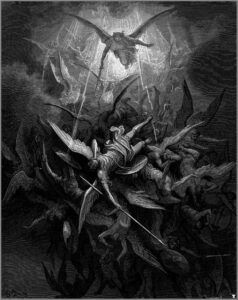
Suda’s interpretation of Zoroaster “demoting” Mithra seems to be largely debunked by religious scholars nowadays, with it being based on the idea that the absence of Mithra’s name from the texts implied his rejection. This may have been partially influenced by Roman Mithraic cults, which in and of itself were based around misconceptions and mistranslations of the Persian Mazdayasna. However, the imagery of a prototypical fallen angel and his identity as the God of Contract still inform his characterization in the game.
Mithra’s own description, in the prologue of 陰約 INYAKU, is actually a play on the Avesta scriptures:
To form a deep connection, because it was right… with his “ten thousand eyes” shining, day and night, past and future, good or bad, even stood in the rift between the light of the heavens and the jet black darkness…
The god’s name was Mithra. Mithra himself was a contract.
I announce (and) carry out (this Yasna) for Mithra of wide pastures, of the thousand ears, and of the myriad eyes, the Yazad (yazata) of the spoken name, and for Raman Khwastra.
Soruce
While it is true that Mithra displays a certain wickedness in how he delights in the tragedies of Hinashiro, it is also true that he is never the initiator of violence: behind the scenes, Mithra offered contracts to Sumio, Ryo, Lil and the Headmaster, the fulfillment of such contracts being what causes the deaths of most of the cast. The only times when he takes a life is when it is offered to him, or when he is directly challenged, as is the case with Arisa and Chisato.
Why does Mithra elect to torture humans? His motivation is clearly just his own amusement, however, Yayoi comments on the destruction wrought upon the natural world by humanity in 浮誘 FUYOU, seemingly out of nowhere. However, Yayoi is often shown as a manipulative liar, so I have to wonder if she used that argument specifically to spur Mithra into haunting the town of Hinashiro, which is ultimately what leads him to his death and liberates her from his influence.
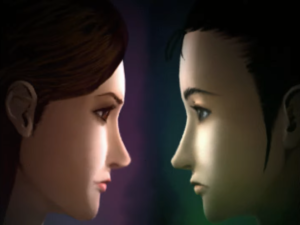
Through the course of the game, Yayoi and Chisato are framed as complete opposites in every way, with Mithra existing above them as a superior entity: Yayoi is a seductress, who wrecks havock while manipulating others through her sexual allure; her domain is modernity, night clubs, shopping districts and apartment complexes. Meanwhile, Chisato represents traditionalism (her being an archer is a deliberate allusion to Shintoism), often trying her best to preserve life and to pacify the spirits of those who already passed. In other words, the two sisters are a manifestation of the dualistic nature of Zoroastrianism, which in and of itself is not limited to “good” and “evil” but a variety of opposites contrasting each other within those two groups.
Mithra, Yayoi and Chisato are gods who are part of the yazatas.
This was set up by having Yayoi and Chisato be Zoroastrian gods as the groundwork.
Strictly speaking, Yayoi is a fusion of Vayu (the wind god) and the Pairilas (witches), who are on the side of the evil god Angra Mainyu, while Chisato is a fusion of Hvar (the sun god) with Rashnu (an angel who symbolises justice), who is on the side of the good god Ahura Mazda.
This means that they are both fusions of gods who are part of Zurvan (time). Because of this, I decided to make them sisters.
※If you compare the gods’ nature of Zurvan to the blood flowing through their bodies, perhaps this makes them like sisters who share the same blood.
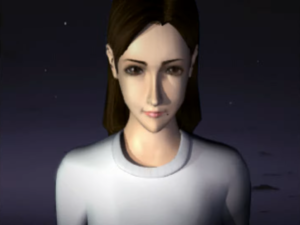
Vayu is part of a dual-faced yazata, Vayu-Vata, with Vayu representing the wind and Vata representing the atmosphere, which explains the visual motif going on through the game where Mithra is framed as being the moon and Yayoi is framed as the empty space surrounding it. Within the context of Zurvan, Vayu-Vata is considered a part of it in the sense that the “atmosphere” and “wind” are stand ins for “space”, which exists within or alongside time. It is interesting to note that Vayu-Vata is referred to as either a yazata (positive spirit serving Ahura Mazda, an angel) or a deva (negative spirit created by Angra Manyu, a demon). This may have also colored Yayoi’s characterization, as she occasionally portrays herself as a victim in need of protection in order to manipulate her victims into acting on her own behalf. At the same time, Suda himself has confirmed that she is not entirely untruthful in her longing for a human connection, implying that, while repressed, a more positive side of Yayoi exists within her:
The “edge of the world” (the big tree scene) is the purest, most primitive place. Yayoi puts aside her good will and other emotions towards Ryo, reuniting with him at the “edge of the world”. There, Yayoi watches Ryo and the conclusion of it all in her most human-like state, then watches Mithra’s death in the real world at the end to bring an end to the story.
The second inspiration for Yayoi’s character is a lot more straightforward: The seductive witches obviously informed her personality as a woman who uses her sexuality as a manipulation tool, and the shooting stars they are associated with also belong in the night sky. However, the term “Pairilas” is either a mistranslation or a mistake on Suda’s part, as I could not find it in any source.
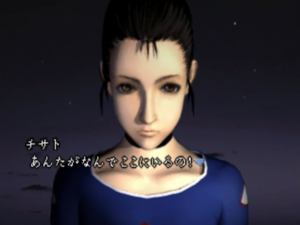
When it comes to Chisato, Hvar-ksata co-existed with Mithra as the former was associated with the full sun (his name literally meaning “Radiant Sun”) while the latter was associated with the rising sun. In late Zoroastrianism, Mithra actually overshadowed Hvar-ksata and began to be worshiped as the sole sun God, reinforcing Chisato’s characterization as an avatar of the traditional morality that western-centric urbanization quickly supplanted. This also clarifies that the moon itself does not represent Mithra, he instead embodies the moonlight, which is comprised of sun rays (Mithra the rising sun) reflected on the moon.
Rashnu is instead a yazata (angel) associated with Justice, and forms a triumvirate with Mithra and Sraosha as judges of the human souls as they cross the Chinvat Bridge. This ritual of passage is actually portrayed in 慟悪 DOWAKU, as the headmaster of Hinashiro high falls to his death:

When the headmaster’s office suddenly collapses in Dowaku, it is seemingly due to a phenomenon caused by Chisato’s will. In the world of Zoroastrianism, it is said that when you die, you cross Chinvat Bridge and receive judgement. If Rashnu’s scales lean towards goodness, the bridge is thick and stable, but if they lean towards evil, the bridge becomes as narrow as a knife and you fall into hell. It is just like the image of falling into hell.
The scene can be quite confusing on a first viewing, since it’s the moonlight itself that seems to cause the floor to collapse; however, once delving into the mythology, it becomes clear: Rashnu and Mithra co-exist as judges, so as Chisato deems the headmaster “unworthy” of passing on, it is Mithra, in accordance to the contract, who executes him by having the floor collapse. Sraosha remains unseen in this transaction (and in the game itself) as his role is that of the psychopomp who guides the souls to the afterlife.
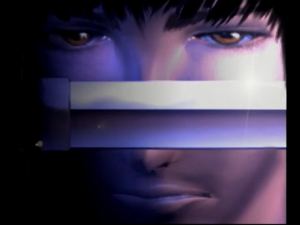
The dual nature of Zoroastrian morality exists both on a cosmic level and on a personal level; according to scripture, humans, who have free will, must choose of their own accord to follow Ahura Mazda and his yazatas while rejecting the false Gods of Angra Manyu. That is why, in the context of Moonlight Syndrome, the celestial chess game that is played by the three angels (Mithra expanding his influence to torture mankind, Yayoi setting up Mithra to die and be free of his influence and Chisato staunchly trying to preserve life) necessitates human pawns. On a surface level, it does not fall to reason that Ryo Kazan, armed with a puny sword, could be the one to exorcise Mithra when he was too powerful for either Chisato or Yayoi to tackle. However, when viewed through a mythological lense, it makes sense: it is only when Ryo exercises his free will that he is able to slay the monster with his inner weapon, which in his case is the will to protect.
Known Islamic terrorist and fellow Paradise Hotel resident “cake” (if that is his real name) also informed me that consanguineous marriage was sanctioned under early Zoroastrianism. Ryo does harbor incestuous feelings towards his sister Kyoko, though said feelings, which he developed due to his own weakness and over-reliance on Kyoko, are considered aberrant. However, in a different era, in a different place, their marriage could have been sanctioned by the core religion, reinforcing Ryo’s image of a man from a different era, unfitting for modern society.

